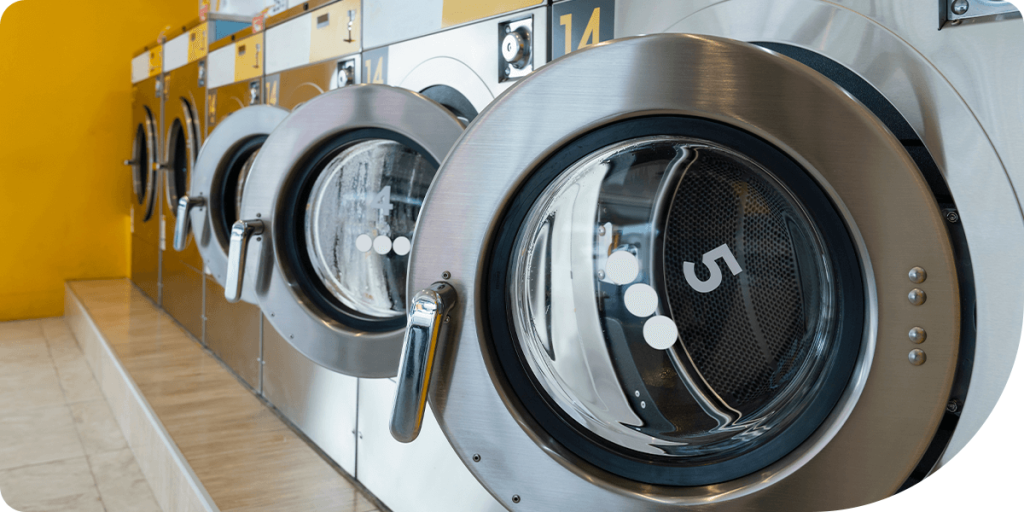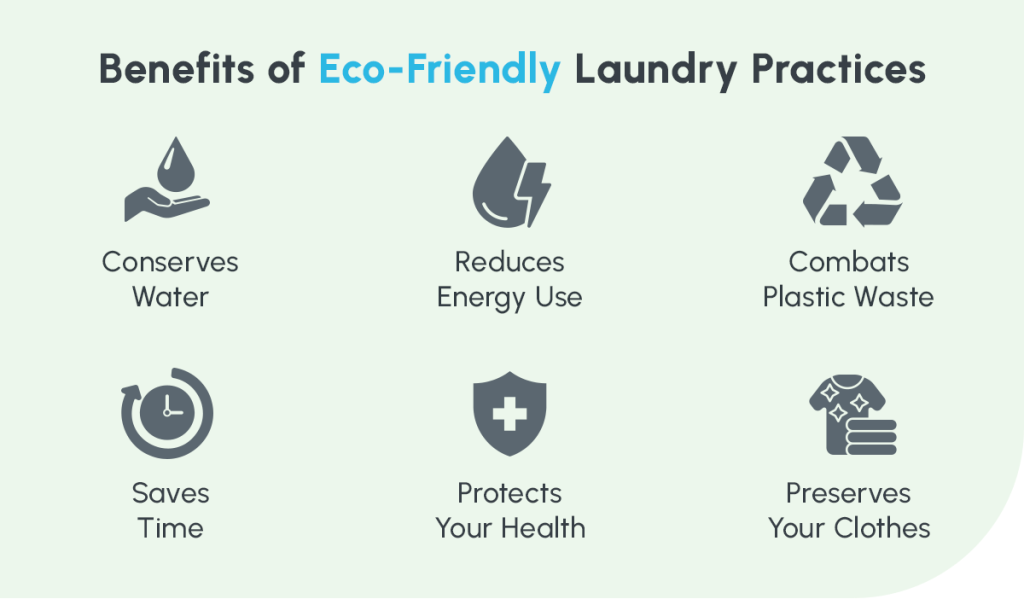


Laundry may not come to mind when thinking about unsustainable practices — what’s so bad about cleaning your clothing, towels and bedding? We have long moved on from preindustrial techniques of cleaning clothes and now rely on machines, chemicals and energy, which have a serious impact on the environment. Luckily, you don’t have to toss out your washing machine and go back to hitting clothes on stones.
Modern ways are convenient, but armed with more awareness of unhealthy laundry habits, you can adopt a greener laundry solution and play your part in preserving the planet’s future.
This guide takes you through green laundry as an alternative.
Green laundry refers to laundry practices that support the environment. It involves using products and taking measures to reduce pollution and wastage, creating a more sustainable approach to cleaning.
By following the responsible practices of eco-friendly laundry, you can minimize the impact that routine washing has on the planet.
Reducing your wardrobe and taking care of your clothes to last longer are excellent strategies to preserve natural resources, minimizing your share of the carbon footprint caused by clothes manufacturing.
However, by doing laundry the regular way, you undo much of your sustainable efforts. Here are reasons regular laundry practices are harmful to the environment and why you should ultimately consider switching to a more eco-friendly solution:
Looking at the statistics, the amount of energy and water needed to clean your laundry every year is staggering. In addition to that, the production processes of detergents and transportation make it clear just how steep costs are for the environment.
Adopting sustainable laundry practices, like using an eco-friendly laundry machine, is the most effective strategy to combat the effects of conventional washing on the environment. You can take a stand by making small changes that are much more friendly to the planet.

Here are the benefits of green laundry:
Knowing the planet has only a small amount of freshwater in ice deposits is eye-opening and should spur you to conserve more water when doing laundry. Green practices like investing in the latest environmentally friendly washer and dryer can help you reduce the amount of water you use for each load.
Any small changes you make to your energy use can have a huge and lasting difference by the end of the year. Considering the excessive amount of energy that goes into washing and drying clothes, adopting conscious habits to improve energy efficiency while washing can significantly lower your overall energy consumption.
Slushing your household’s energy consumption helps preserve natural resources, but it also has a direct impact on your energy bill. Energy-efficient washers, for example, use 20% less electricity than regular washers. If you add to that other energy-saving green practices, you’ll significantly lower your energy bills over the course of a year.
Nowadays, synthetic materials make up a huge percentage of fibers in clothes. Common plastic fibers in fabrics include acrylic, nylon and polyester. While conventional filtration systems break down wastewater, they are not designed to filter out tiny plastic particles, which eventually end up in water systems.
You still need to wash your laundry, but a sustainable approach will reduce your share of microplastics in the environment. Green habits will also reduce your reliance on plastic packaging, which ends up in landfills and water systems more often than it is recycled.
Eco-friendly laundry practices like less frequent washes and opting for cold water settings can save you time and energy.
For instance, college students with tough schedules may struggle to fit laundry into their busy lifestyles, and these techniques can free up valuable time they can use to focus on studying or other activities.
Eco-friendly laundry minimizes the use and disposal of harsh chemicals that are just as disruptive to ecosystems as plastics. While green habits are good for the environment, they also support your health and everybody else’s. Some harmful chemicals in certain detergents are linked to various health complications. Avoiding them protects you from exposure.
When these chemicals contaminate water systems, they harm aquatic life, and since we consume fish, the same chemicals enter our bodies. Your conscious effort to practice green laundry prevents the release of more chemicals into water sources, protecting other people from exposure.
Unlike regular washing, which uses harsh products, green cleaning is kinder to your fabrics and helps keep them in good condition for much longer.
There is a ripple effect — wearing your clothes for longer periods without needing to replace them decreases the demand to manufacture new clothes, which often harms the environment.
Knowing the downsides of regular washing habits and the benefits of switching to green laundry, you might wonder how to introduce a more eco-friendly routine. Here are ways to implement sustainable laundry practices:
Washers use a lot of electricity and water to get your clothes looking fresh and clean. The consumption is worse if you’re holding on to an old model that has been around for a decade or more. If you’re using a newer washer, consider the type because some are more water and energy-efficient than others.
Generally, front-loaders are more efficient than top loaders, which need more water and energy due to impellers. However, you want to pay attention to both the type and energy rating because ENERGY STAR-certified front-loaders use 50% less water than top-loaders and nearly half the energy.
Your washer uses most of the energy it consumes to heat the water. Using the cold setting lowers your household energy use, saving you money on utility bills and the planet’s resources in the process.
Since you can wash most clothes in cold water, stick with lower temperatures for normal washings and reserve hot water settings for instances when your items are more heavily soiled.
Washing machines have different cold settings — is cold or tap cold better for laundry? Tap cold means your machine uses water at the existing tap temperature, which can be pretty cold in winter. For the cold mode, your washer cycles in a bit of hot water to achieve a standard temperature, and clothing is typically washed on a delicate setting.
Depending on your preference, you could use either of these eco-friendly settings. There are many benefits to washing in cold water. Here are a few that have a direct impact on the environment:
Sometimes cold water is not an option, such as when you’re ill or it’s freezing. That’s where the choice of eco-warm vs. warm comes in. The warm setting is a perfect balance between cold and hot, which still allows you to save on energy.
So, what is eco-warm on a washing machine? Modern washers now have an eco-mode setting that’s different from the regular warm mode because it does more than use much lower temperatures than hot or warm settings. It also uses less water to achieve the same level of cleaning possible with other system options.
Washing full loads is a simple but high-impact tactic. Running full loads without overloading the machine reduces the frequency of loads you wash, decreasing energy and water usage. You could combine washing full loads with washing less frequently to maximize the positive impact on the environment.
Unless it’s an undergarment or made from synthetics that trap odor, there’s no need to wash it every single time you wear it. Ultimately, re-wearing clothes before tossing them into the laundry can help you cut back so often that you do not hit around 300 or more loads per year.
Most of the detergents we use may not be safe for us or the environment. When ranking and verifying laundry products, the Environmental Working Group gave 68% of the products in the study a failing grade, meaning they didn’t meet the toxicity standards for human use. Avoid products containing harmful chemicals by ensuring established bodies like the EPA have approved them.
There are many eco-friendly alternatives to laundry detergent on the market. You can find brands that follow sustainable practices and have genuine labels from recognized agencies.
You could also resort to natural biodegradable detergents that are easy to make from home. Combining distilled white vinegar with some baking soda, for instance, can replace ordinary detergents and disinfect laundry naturally. They are safer for you and the environment.
In addition to harmful detergents, you may also want to avoid chlorine bleach and use oxygen bleach instead. Oxygen bleach is far more eco-friendly, as it naturally breaks down into water and oxygen. Lemon juice is another mild but effective alternative to regular bleach. You could whiten clothes with lemon juice just by soaking them overnight in a basin with a generous amount of the juice.
Dryers are much more energy-intensive than washers. They also contribute to more microfiber pollution because the high heat can break down fabrics. While a dryer is convenient, it’s nowhere near green. The greenest option is traditional air drying. Whenever possible, ditch the dryer, hang your garments and fabrics on a clothesline and let them dry the traditional way.
Hanging clothes outside to air dry is best, as the sun’s UV rays kill bacteria. However, you can also air dry indoors and avoid the cost of tumble drying for you and the environment.
If airdrying is not an option, clean the lint trap to improve dryer performance and maximize energy efficiency. Since heat and friction remove lint from clothes, it’s easy for lint to accumulate and restrict air flow, which leads to poor performance and more energy use.
Opt for the minimum amount of detergent for each load. Using less of these products can help reduce chemical pollution and energy consumption.
In addition to reducing detergent use, you can separate certain fabrics for greater energy efficiency. Separate towels from linen, for example, to reduce dry time and clean them faster.
Considering the high volume of microplastics in our soil and oceans, it makes sense to combat the problem directly. The most effective method is to attach a microfiber filter to your washing machine. During wash cycles, your fabrics shed microfibers, and the filter catches them before they escape into your drain.
Implementing effective laundry technology can also contribute to green laundry practices by optimizing machine usage and reducing water and energy consumption.
The choices we make today impact the environment and shape the planet’s future. If there’s any good sustainable laundry advice, it is that your efforts to improve the planet add up over time. Whether using less detergent, air drying or eco-friendly washing, it still makes a big difference to the environment.
At Caldwell & Gregory, we understand the value of sustainable practices, so our laundry equipment features the latest quality standards and technologies. Our commercial laundry solutions come with exceptional customer support and dedicated preventive maintenance to ensure nothing stands in the way of your sustainable approaches.
Get in touch with our experts to learn how we can help!
